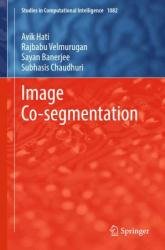Image Co-segmentation
- Добавил: literator
- Дата: 6-02-2023, 18:24
- Комментариев: 0
 Название: Image Co-segmentation
Название: Image Co-segmentationАвтор: Avik Hati, Rajbabu Velmurugan, Sayan Banerjee
Издательство: Springer
Серия: Studies in Computational Intelligence
Год: 2023
Страниц: 231
Язык: английский
Формат: pdf (true), epub
Размер: 10.2 MB
This book presents and analyzes methods to perform image co-segmentation. In this book, the authors describe efficient solutions to this problem ensuring robustness and accuracy, and provide theoretical analysis for the same. Six different methods for image co-segmentation are presented. These methods use concepts from statistical mode detection, subgraph matching, latent class graph, region growing, graph CNN, conditional encoder–decoder network, meta-learning, conditional variational encoder–decoder, and attention mechanisms. The authors have included several block diagrams and illustrative examples for the ease of readers. This book is a highly useful resource to researchers and academicians not only in the specific area of image co-segmentation but also in related areas of image processing, graph neural networks, statistical learning, and few-shot learning.
Image segmentation is a classical and well-known problem in image processing, where an image is partitioned into non-overlapping regions. Such regions may be objects or meaningful parts of a scene. It is usually a challenging task to perform image segmentation and automatically extract objects without high-level knowledge of the object category. Instead, if we have two or more images containing a common object of interest, jointly trying to segment the images to obtain the common object will help in automating the segmentation process. This is referred to as the problem of image co-segmentation. This monograph explores several approaches to perform robust co-segmentation of images.
The problem of co-segmentation is not as well researched as segmentation. For us, the motivation for understanding image co-segmentation arose from considering the problem of identifying videos with similar content and also retrieving images by searching for a similar image, even before Deep Learning became popular. We realized that earlier approaches had considered saliency of an object in an image as one of the cues for co-segmentation. However, realizing various restrictive issues with this approach, we started exploring other methods that can perform robust co-segmentation. We believe that a good representation for the foreground and background in an image is essential, and hence use a graph representation for the images, which helped in both unsupervised and supervised approaches. This way we could use and extend graph matching algorithms that can be made more robust. This could also be done in the deep neural network framework, extending the strength of the model to supervised approaches. Given that graph-based approaches for co-segmentation have not sufficiently been explored in literature, we decided to bring out this monograph on co-segmentation.
In this monograph, we present several methods for co-segmentation that were developed over a period of seven years. Most of these methods use the power of superpixels to represent images and graphs to represent connectedness among them. Such representations could exploit efficient graph matching algorithms that could lead to co-segmentation. However, there were several challenges in developing such algorithms which are brought out in the chapters of this monograph. The challenges both in formulating and implementing such algorithms are illustrated with analytical and experimental results. In the unsupervised framework, one of the analytical challenges relates to the statistical mode detection in a multidimensional feature space. While a solution is discussed in the monograph, this is one of the problems still considered to be a challenge in Machine Learning algorithms.
After presenting unsupervised approaches, we present supervised approaches to solve the problem of co-segmentation. These methods lead to better performance with sufficiently labeled large datasets of images. However, with fewer images, these methods could not do well. Hence, in the monograph, we present some recent techniques such as few-shot learning to solve the problem of having access to fewer samples during training for the co-segmentation problem. In most of the methods presented, the problem of co-segmenting a single object across multiple images is presented. However, the problem of co-segmenting multiple objects across multiple images is still a challenging problem. We believe the approaches presented in this monograph will help researchers to address such co-segmentation problems and in a less constrained setting.
Most of the methods presented are good references to practicing researchers. In addition, the primary target group for this monograph is graduate students in electrical engineering, Computer Science, or mathematics who have interest in image processing and Machine Learning.
Contents:
1. Introduction
2. Survey of Image Co-segmentation
3. Mathematical Background
4. Maximum Common Subgraph Matching
5. Maximally Occurring Common Subgraph Matching
6. Co-segmentation Using a Classification Framework
7. Co-segmentation Using Graph Convolutional Network
8. Conditional Siamese Convolutional Network
9. Few-shot Learning for Co-segmentation
10. Conclusions
Скачать Image Co-segmentation
[related-news] [/related-news]
Внимание
Уважаемый посетитель, Вы зашли на сайт как незарегистрированный пользователь.
Мы рекомендуем Вам зарегистрироваться либо войти на сайт под своим именем.
Уважаемый посетитель, Вы зашли на сайт как незарегистрированный пользователь.
Мы рекомендуем Вам зарегистрироваться либо войти на сайт под своим именем.
